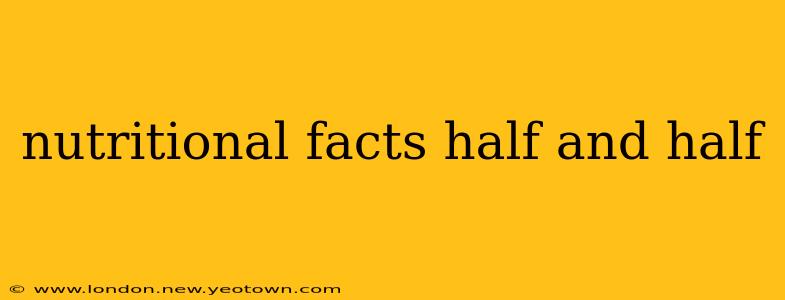Decoding the Creamy Truth: Nutritional Facts of Half-and-Half
Half-and-half. That creamy, dreamy dairy delight that elevates our coffee, soups, and sauces. But have you ever stopped to consider what's really in that carton? It's more than just milk and cream; it's a blend of flavors and nutrients, some beneficial, some less so. Let's dive into the nutritional facts of half-and-half and uncover the creamy truth behind this popular kitchen staple.
Our journey starts with a simple understanding: half-and-half is, as the name suggests, a roughly 50/50 blend of whole milk and cream. This simple combination gives it a richer, thicker texture and a higher fat content than milk alone. But the exact nutritional profile can vary slightly depending on the brand and even the season, as the milk fat content itself fluctuates.
What are the main nutritional components of half-and-half?
This is the core question. Half-and-half is primarily composed of fat, protein, and carbohydrates – the macronutrients our bodies rely on for energy and building blocks. The specific amounts, however, are key to understanding its place in a balanced diet. Generally, a single serving (about ¼ cup or 60ml) will contain:
- Fat: This is where the bulk of the calories come from. The high fat content is what gives half-and-half its creamy texture and rich flavor.
- Protein: A modest source of protein, contributing to satiety and muscle building, though not as significant as in other dairy products.
- Carbohydrates: Primarily lactose, the natural sugar in milk. The amount is relatively small compared to the fat content.
- Vitamins and Minerals: Like milk, half-and-half contains various vitamins and minerals, albeit in varying quantities. Calcium and Vitamin D are usually present, vital for bone health.
Remember, these are general estimates; always check the nutrition label on your specific brand for the most accurate information.
How many calories are in half-and-half?
This is a common concern, and rightly so! The calorie count in half-and-half is significantly higher than in regular milk due to its higher fat content. A single serving (again, about ¼ cup) can easily contain between 50 to 70 calories, depending on the brand. Adding it to your coffee several times a day can quickly add up.
Is half-and-half healthier than heavy cream?
This is a great comparison to make! Yes, half-and-half is generally considered healthier than heavy cream because it has a lower fat content. Heavy cream is almost pure fat, significantly increasing the calorie count and saturated fat intake. Half-and-half offers a compromise: some of the cream's richness without the extreme calorie density.
What are the potential health benefits and drawbacks of consuming half-and-half?
This gets to the heart of the matter: moderately enjoying half-and-half can provide some benefits, like calcium for bone health. However, its higher fat and calorie content means that excessive consumption could contribute to weight gain or negatively impact cholesterol levels. As with all food choices, moderation is key.
Are there any alternatives to half-and-half?
Absolutely! For those watching their calorie or fat intake, there are several alternatives:
- Low-fat milk: A much lower-calorie option, though it lacks the richness of half-and-half.
- Plant-based creamers: Soy, almond, oat, or coconut creamers offer dairy-free alternatives with varying fat and calorie contents. Be sure to check the labels as they can vary greatly.
In conclusion, half-and-half offers a delightful creamy texture and flavor, but it's crucial to be mindful of its nutritional profile. Understanding its calorie and fat content allows you to make informed choices that fit your dietary needs and health goals. Moderation, as always, is the key to enjoying this tasty dairy delight without compromising your health.

